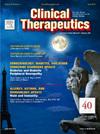Diagnostic and Prognostic Roles of Inflammatory Biomarkers in Patients With Coronary Heart Disease and Heart Failure Treated With Empagliflozin
IF 3.6
4区 医学
Q2 PHARMACOLOGY & PHARMACY
引用次数: 0
Abstract
Purpose
Coronary artery disease (CAD) and heart failure (HF) are leading causes of global morbidity and mortality and pose economic burden. This study aims to examine the diagnostic and prognostic significance of biomarkers in patients with CAD and HF treated with empagliflozin.
Methods
In a prospective, case-control study, 180 participants were divided into 3 groups: patients with stable angina (CAD) and patients with HF on empagliflozin 10 mg daily for 6 months compared with healthy controls. Biomarker levels were measured at baseline, with hospital readmission rates monitored over 30 and 90 days. Stepwise logistic regression was used to predict hospital readmissions with and without participant clinical features. All relevant independent variables were then included in a single model using multiple logistic regression.
Findings
Significant differences in biomarker profiles were observed across groups, indicating the differential significance of these biomarkers in diagnostic and prognostic aspects. Multinomial logistic regression identified 3 biomarkers as key diagnostic markers for CAD and HF: homocysteine (relative risk ratio [RRR] = 16.5 for CAD), fetuin A (RRR = 1.1 for HF), and visfatin (RRR = 30.4 and 23.1 for CAD and HF, respectively). Prognostic analysis by multiple logistic regression identified visfatin (odds ratio = 6.5) and high-sensitivity C-reactive protein (odds ratio = 1.9) as significant predictors of hospital readmission for patients with CAD and HF, respectively.
Implications
The study underscores the promising role of selected biomarkers in the diagnosis and prognosis of CAD and HF diseases. These findings suggest the integration of biomarker profiling into clinical protocols to enhance patient care and outcomes in cardiovascular disease, especially in those treated with empagliflozin. Even if these indicators have potential, further larger size, long-term research is required to confirm their use in clinical settings. ClinicalTrials.gov identifier: NCT05911724.
炎症生物标志物在恩格列净治疗的冠心病和心力衰竭患者中的诊断和预后作用
目的:冠状动脉疾病(CAD)和心力衰竭(HF)是全球发病率和死亡率的主要原因,并造成经济负担。本研究旨在探讨生物标志物在恩格列净治疗的冠心病和心衰患者中的诊断和预后意义。方法:在一项前瞻性病例对照研究中,180名参与者被分为3组:稳定型心绞痛(CAD)患者和HF患者,与健康对照组相比,每天服用恩格列净10mg,持续6个月。在基线时测量生物标志物水平,并在30天和90天内监测再入院率。逐步逻辑回归用于预测有或无临床特征的再入院率。然后使用多元逻辑回归将所有相关自变量包含在单个模型中。研究结果:在不同组中观察到生物标志物谱的显著差异,表明这些生物标志物在诊断和预后方面的差异意义。多项logistic回归确定了3种生物标志物作为CAD和HF的关键诊断标志物:同型半胱氨酸(CAD的相对风险比[RRR] = 16.5)、胎儿素A (HF的RRR = 1.1)和visfatin (CAD和HF的RRR分别为30.4和23.1)。通过多元logistic回归的预后分析发现,visfatin(优势比= 6.5)和高敏c反应蛋白(优势比= 1.9)分别是CAD和HF患者再入院的重要预测因素。意义:该研究强调了选定的生物标志物在冠心病和心衰疾病的诊断和预后中的有希望的作用。这些发现表明,将生物标志物分析纳入临床方案,以加强心血管疾病患者的护理和预后,特别是那些接受恩格列净治疗的患者。即使这些指标有潜力,也需要进一步大规模的长期研究来证实它们在临床环境中的应用。临床试验:gov标识符:NCT05911724。
本文章由计算机程序翻译,如有差异,请以英文原文为准。
求助全文
约1分钟内获得全文
求助全文
来源期刊

Clinical therapeutics
医学-药学
CiteScore
6.00
自引率
3.10%
发文量
154
审稿时长
9 weeks
期刊介绍:
Clinical Therapeutics provides peer-reviewed, rapid publication of recent developments in drug and other therapies as well as in diagnostics, pharmacoeconomics, health policy, treatment outcomes, and innovations in drug and biologics research. In addition Clinical Therapeutics features updates on specific topics collated by expert Topic Editors. Clinical Therapeutics is read by a large international audience of scientists and clinicians in a variety of research, academic, and clinical practice settings. Articles are indexed by all major biomedical abstracting databases.
 求助内容:
求助内容: 应助结果提醒方式:
应助结果提醒方式:


